Your 3-Day Guide to Andros Island
Shady hiking trails, a vibrant cultural...
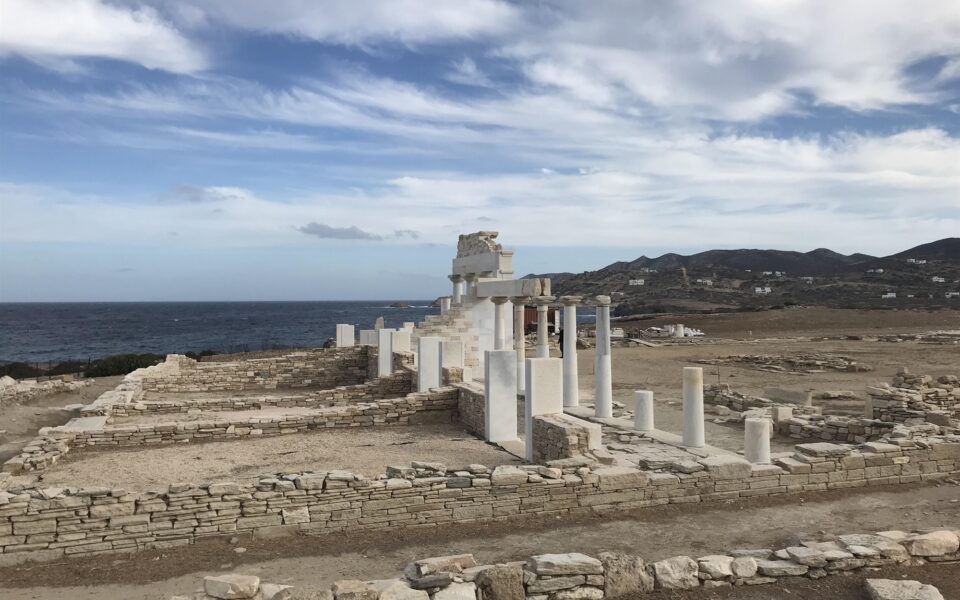
Restoration works on Despotiko started in mid-May.
© Hellenic Ministry of Culture and Sports
As we emerge from the coronavirus pandemic, archaeologists are returning to their excavation projects at sites on the Aegean islands and mainland Greece. Following two years of restrictions, during which time smaller research teams continued to work, a significant number of excavation projects will resume in earnest this summer, with the help of large numbers of students from Greek and foreign universities.
Mutations of the Covid-19 virus may not have completely disappeared, but the relaxation of the measures will allow for the research to be carried out according to the usual scientific standards. “This year we will resume systematic excavations after two years,” says Dimitris Athanasoulis, Director of the Ephorate of Antiquities of the Cyclades, optimistic that at many excavations “we expect extremely important findings.”
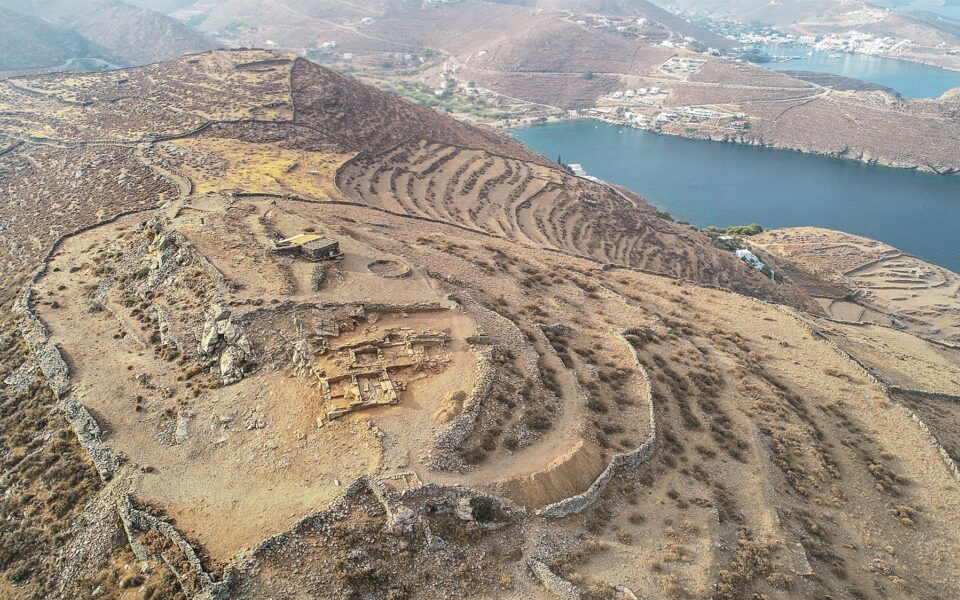
The acropolis of the island of Kythnos is among several sites in the Aegean where excavations are resuming after a two year hiatus imposed by pandemic restrictions.
© Kostas Xenikakis
For the Ephorate of Antiquities of the Cyclades, the number of excavations across the region will significantly increase this year. A new excavation will start on Naxos, at the site of Kato Choria in the Castle of Apaliros (a collaboration between the Ephorate and the British School at Athens), where an important Byzantine settlement of the first millennium has been identified. “It is expected to give information about a difficult transitional period for Byzantium. For the first time, we will dig a rural settlement dating from this era,” explains Athanasoulis. Another excavation project is also being launched on Tinos in collaboration with the National Hellenic Research Foundation (NHRF), a joint program that will investigate the Byzantine and medieval periods of the island. The project will focus on an early Christian basilica at the site of Rentia, co-directed by Athanasoulis and Anastasia Yiangaki, an archaeologist from NHRF.
A new pilot project, “Ancient Vision,” which will allow for the digital transmission of archaeological research through an online platform, starts on Mykonos this summer. Primarily addressed to students and scholars, the project will initially focus on the site of Palaiokastro in Ano Mera. The work will then turn to the sacred island of Delos and the single-aisled basilica dedicated Aghios Kirikos, dating from the middle of the 6th century, where excavations will be broadcasted in real time. “Students will also have the opportunity to watch stratigraphy being uncovered at the Askafos temple.”
On Sifnos, interdisciplinary research will be carried out for the first time, with a special emphasis on the prehistoric periods and the early exploitation of the island’s metals. On Kythnos, the excavation of Vryokastro will continue, co-directed by Athanasoulis and Alexandros Mazarakis-Ainian, professor of archaeology at the University of Thessaly. Athanasoulis will continue later in the season with Zozi Papadopoulou and Maria Sigalas in an ambitious project to map the antiquities on the mysterious and uninhabited island Rineia.
Another important excavation will take place at the Castle of Chora on Mykonos, an island with an uninterrupted history that stretches back at least 5,000 years. In addition, research continues at the castle on Antiparos, where a huge Venetian tower was recently discovered. On Ios, Mariza Marthari will conduct further research at the prehistoric settlement of Skarkos, while on the island of Thirasia, Kostas Sbonias and Iris Tzahili from the Ionian University will continue excavations at an Early Cycladic site. Further research programs in the Cyclades this year will target sites on the uninhabited islets around Milos and Kimolos. For the first time, the uninhabited Polyaigos will be systematically investigated.
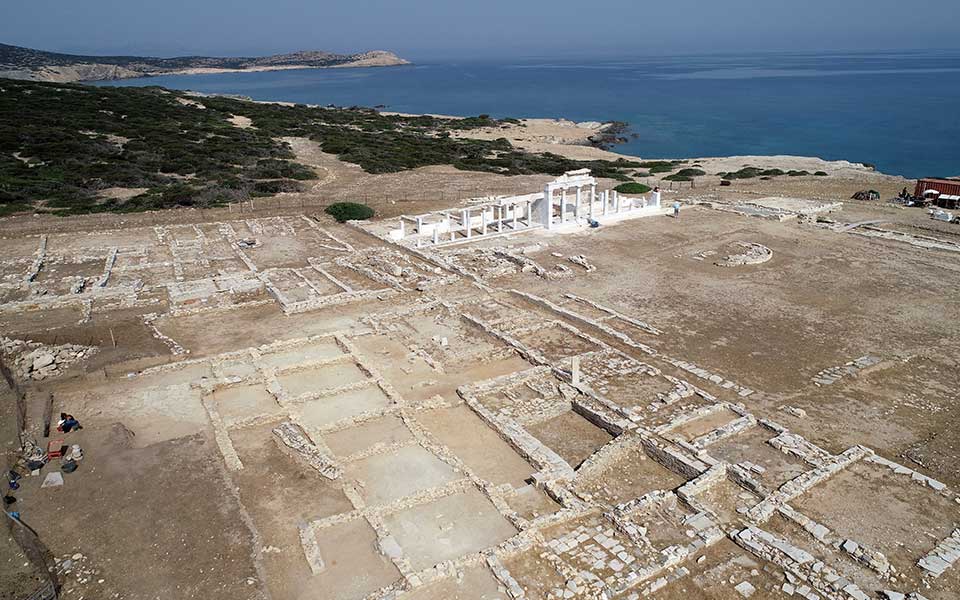
Despotiko
© Hellenic Ministry of Culture and Sports
Work has resumed on the uninhabited island of Despotiko, west of Antiparos, co-directed by Yiannos Kouragios. Systematic research, which began in 1997, has brought to light an extensive site of cult worship – the largest in the Cyclades after that of Delos. Now, restorations are proceeding in the temple-shaped building D, a cult building dating to 530 BC with four columns and a distinctive looking gabled roof. Excavations began earlier in May, aimed at the buildings of the eastern complex, and the impressive cisterns that were discovered last year. Targeted research will also focus on the intervening islet of Tsimintiri, where two large buildings and a square, likely used for ritual dances, recently came to light.
“The great thing this year is that 40 students from foreign universities are coming, as well as Greek students from the University of Ioannina. We’re slowly returning to normality, but with a few precautions in place,” says Kouriagos. The project is being co-directed with Alexandra Alexandridou, assistant professor at the University of Ioannina, and his close collaborator Ilia Daifa from the University of Thessaly. Financial support is coming from AIGEAS NON-PROFIT, the P. & A. Kanellopoulos Foundation, and the A. G. Leventis Foundation.
On the island there are small visible changes. Apart from the route for visitors arriving at the pier, this year there is an hourly-paid guard in the area, and the whole peninsula has been fenced, at the expense of the municipality. It remains for the Ministry of Culture to set a ticket price and organize visitor facilities (toilets, etc.).
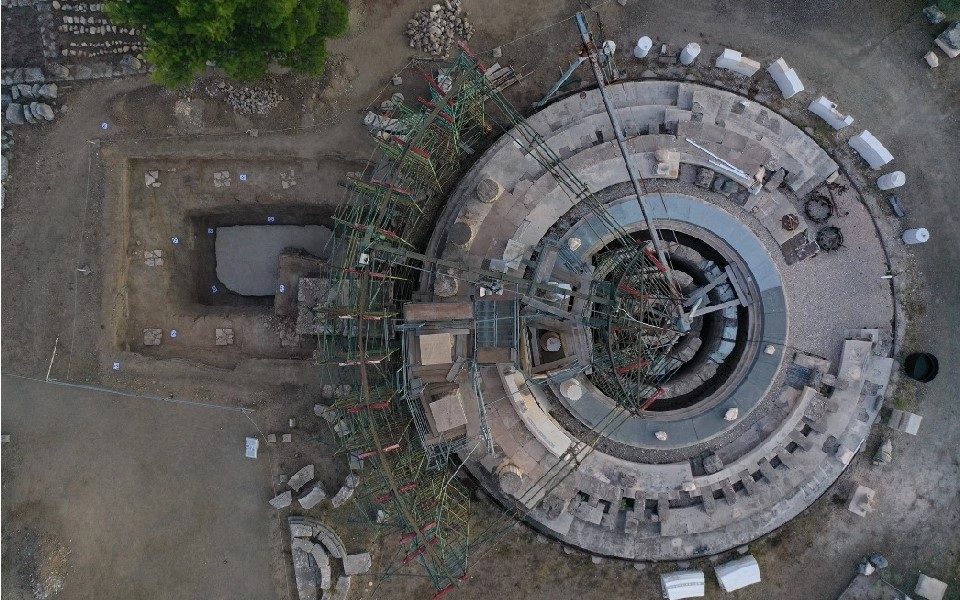
A small subterranean building to the right of enigmatic Tholos at Epidaurus was discovered last year.
© Hellenic Ministry of Culture and Sports
At the end of June, Emeritus Professor of Archaeology Vassilis Lambrinoudakis begins the excavation in the area of the mysterious Tholos building at Epidaurus, in collaboration with the Ephorate of Antiquities of the Argolid and the University of Athens, and with funding from the Stavros Niarchos Foundation. From late August until mid-September, Lambrinoudakis and his team will be joined by a group of students from Princeton, and German students on the Erasmus program.
“At the Asclepieion, we believe that we will finish with the building, specifically the basement that was an unexpected discovery,” says the excavator. “The archaic building of the 6th century BC, which was built next to the emblematic Tholos, had an underground space similar to the ground floor, complete with a mosaic floor, and provided new information. It is a forerunner of the mystical Tholos – a place of chthonic worship of Asclepius – and was demolished when it was decided to build the new one. Everything indicates that Asclepius arrived at Epidaurus much earlier than we thought.
Last year, the excavation team located all four sides of the monumental basement and reached its southwest corner, where there is a large basin embedded in the well-preserved mosaic floor. Apparently, this was where they gathered and prepared the liquids for some ritual. This basement also had a staircase. Some symmetrical ‘markings’ on the floor testify to the fastening of tables – this year we will examine what kind of rituals were carried out here.”
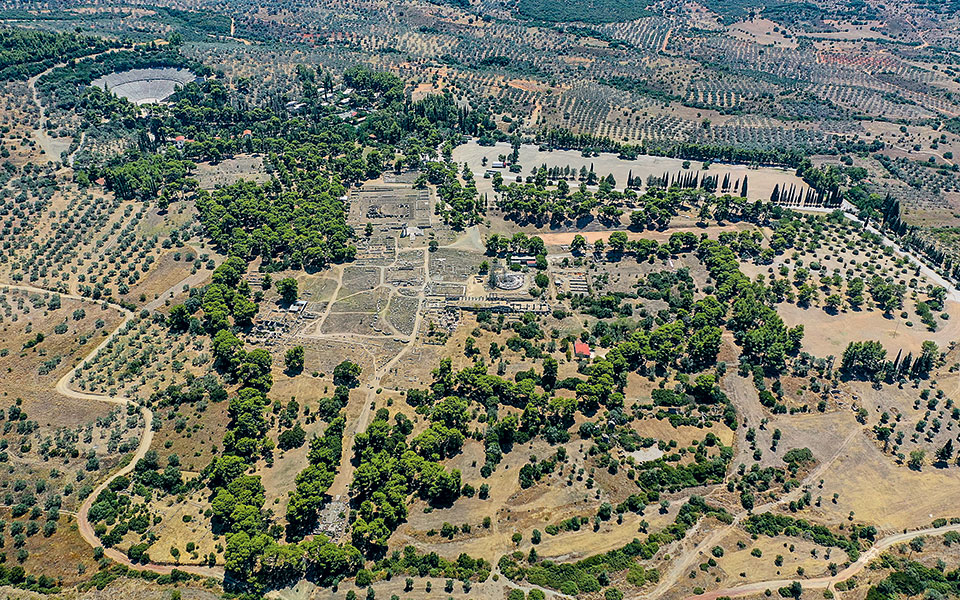
The Sanctuary of Asclepius in Epidaurus
© Hellenic Ministry of Culture and Sports
A second excavation will take place in the city of ancient Epidaurus itself, where, last December, a life-sized female statue was discovered in the area of the ancient agora.
“Those who have walked from the port to the small theater will have seen the ruins of a large Roman building,” says Lambrinoudakis. “That’s where we concentrated our efforts. In Roman times, there was the stoa and a cistern. Behind the stoa we found a large terrace, dated to the 4th century BC. There we found the marble statue of a woman, dating to the imperial Roman period, alongside a large number of votive offerings. This year we will dig deeper.”
Research will also focus on the so-called Fountain building, near the small theater. It is hoped that the discovery of new elements of the complex will encourage its positive identification, as described by the 2nd century traveler Pausanias.
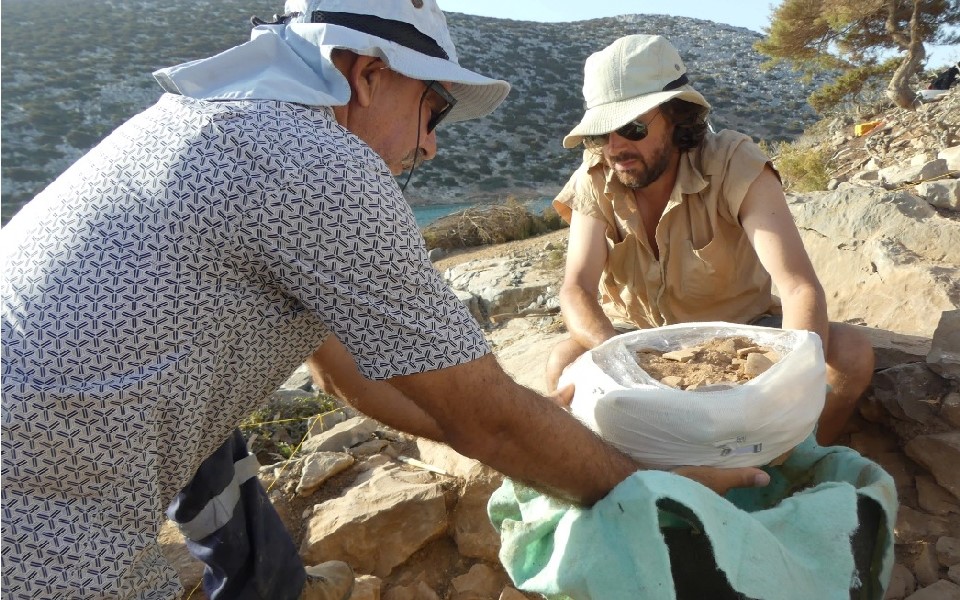
Astypalaia. Archaeologists Ioannis Stavlas and Nikos Sepetzoglou excavating a ceramic vessel during the 2021 season.
© Hellenic Ministry of Culture and Sports
At the rugged site of Vathi on the island of Astypalaia, director of the excavation Andreas Vlachopoulos awaits the arrival of 25 archaeologists, architects, conservators, and students to start work in July. Among them is a group of British scientists. The program includes 15 days of study of all the findings from the previous excavation season and then, in September, three weeks of targeted research in the field.
For the last 10 years, archaeological research carried out under the auspices of the Archaeological Society at Athens, with the support of the University of Ioannina, has yielded impressive results. Last year, at the monumental constructions on the east coast of the cape, a number of intact, child burials were discovered. “The last thing I expected was a cobbled ‘platform’ on the plateau, located inside the retaining walls. At a specific place, four large clay pots from about 3000 BC were found in a group next to each other, with burials of infants. This will be the focus of a small excavation this year by Simon Hilson, Professor of Anthropology at the University of London, with the assistance of the researcher Aliki Giannikou of the University of Ioannina. The aim is to clarify this hitherto unknown burial custom in the prehistoric Aegean,” explains the excavator.
Outside the vessels were found shells and pebbles, also burnt seeds and fruits, possibly remnants of burial rituals. “There are no individual offerings, but a collective honor. Only in one burial we found five years ago, near the baby’s skull, a nice stone bead. The society of the living is separated from the object that, until then, had utilitarian significance, but abolishes it in memory of the dead child. It gives the child offerings from the tool reserve of the community. The fact that an excavation in four different parts of the cape highlights the extent of this burial custom.”
Another great surprise was the discovery of a new type of marble figurine last year, on the upper surface of the site. As the director of the excavation and associate professor of Prehistoric Archaeology at the University of Ioannina explains, “it has the plasticity of the Neolithic but the abstraction of the Early Cycladic.” In the place where it was found there are around rock paintings of ships, spirals, and swordfish, dating to the 3rd millennium BC. Supporters of the excavation are the AEGEAS AMKE of Thanasis Martinos, and the General Secretariat of the Aegean in Mytilene.
This article was previously published in Greek at kathimerini.gr.
Shady hiking trails, a vibrant cultural...
Explore Ancient Messene, enjoy the local...
From traditional dances and global rhythms...
Discover festivals, beaches, food, and hidden...